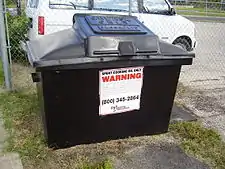Yellow grease
Yellow grease, also termed used cooking oil (UCO), used vegetable oil (UVO), recycled vegetable oil, or waste vegetable oil (WVO), is recovered from businesses and industry that use the oil for cooking.

It is used to feed livestock, and to manufacture soap, make-up, clothes, rubber, and detergents.[1] Due to competition from these other industrial sectors, the EIA estimates that less than a third of yellow grease could be spared for biodiesel production annually.[2]
It is distinct from brown grease; yellow grease is typically used frying oils from deep fryers, whereas brown grease is sourced from grease interceptors.[3]
Other uses of the term
Yellow grease can also refer to lower-quality grades of tallow (cow or sheep fat) from animal rendering plants.
The term has been in use for some time. A source from 1896 describes it as follows: "Yellow grease is made by packers. All the refuse materials of the packing houses go into the yellow grease tank, together with any hogs which may die on the packers' hands."[4]
See also
- Bioliquids
- Biodiesel
- Vegetable oil fuel
- Cooking oil
- Vegetable oils as alternative energy
- Vegetable oil recycling
- Gutter oil (oil drainage or brown grease)
- Fatberg
Notes
- Murphy, Denis J. Plant lipids: biology, utilization, and manipulation. Wiley-Blackwell, 2005, p. 117.
- Radich, Anthony Biodiesel Performance, Costs, and Use
- Brown Grease Feedstocks for Biodiesel. K. Shaine Tyson, National Renewable Energy Laboratory. Available from Northeast Regional Biomass Program. Retrieved January 31, 2009
- Brannt, William Theodore and Schaedlerm Karl. A practical treatise on animal and vegetable fats and oils. H.C. Baird, 1896, p. 110.
External links
- "Grease Rustlers" by Susan McCarthy. Salon.com, November 6, 2000.